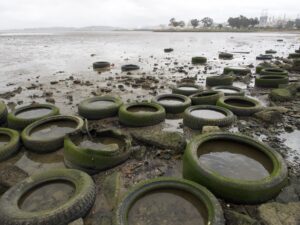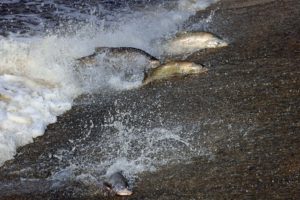Coho salmon are on the verge of collapse in Northern California, but Marin County’s effort to save one of the largest populations is in dispute.
Salmon conservationists say that the county is bending to developers with a new ordinance that has too many loopholes to adequately protect watershed streams and vegetation, critical habitat for the coho. Some homeowners, meanwhile, contest that the ordinance strips them of basic land rights.
The debate has become so heated that conservationists assume that the recent destruction of a fish trap box, used to monitor salmon populations, is linked to a vandal angry at salmon advocates.
The proposed fish protection ordinance has been in the works since 2007, when county officials at the urging of the Salmon Protection and Watershed Network (SPAWN) began taking seriously the habitat destruction along streams caused by development projects. The end product, a 20-page set of regulations, establishes a 100-foot buffer along streams that are deemed important conservation areas to the spawning coho.
But salmon advocates say they’d rather have no ordinance than this one.
“The bottom line is, when we talk about balance, the population of coho has been reduced by about 90 to 95 percent,” said SPAWN’s executive director Todd Steiner. “The ordinance would allow an additional 500,000 square ft. of development (in the San Geronimo Valley).”

Coho salmon, a species of anadromous fish native to the pacific coast, migrate up Lagunitas Creek and its tributaries each winter to spawn. After hatching, the juvenile salmon spend one to two years in the creek and often migrate to the ocean in late spring.
The coho that call Lagunitas Creek home are 10 to 20 percent of a larger unit known as the Central California Coast (CCC) Coho Salmon. When their numbers dropped to just 1 percent of historic levels back in 1999, they were named a federally endangered species. In the 2007 federal recovery plan for the coho, development in the Lagunitas Creek Watershed was deemed “very threatening” to the salmon’s habitat.
In response, county officials want to require permits for development alongside the creek. But SPAWN says too many exemptions would be allowed. Among the work requiring no public oversight: installation of irrigation pipes, driveway paving, replacing public utility infrastructure, and removing fire-prone vegetation, or vegetation considered to be a “public nuisance.”
SPAWN also worries that county’s proposed ordinance would allow “over-the-counter” permits — for small additions, new ramps or pathways, and retaining walls —that would be too easily obtained and include little environmental review.

The San Geronimo Valley Stewards, an organization that represents local property owners, contests that the ordinance is unnecessarily excessive, and a 35-foot buffer would be adequate to protect the salmon (rather than the proposed 100-foot buffer). Bay Nature attempted reach the Stewards for comment, but has received no reply.
Another sticking point in the ordinance is the protection of riparian vegetation. SPAWN notes that only stream-dependent plants (those with roots under the water table) are protected, leaving stream-independent plants (those that don’t), such as bay and redwoods, vulnerable to removal.
Both, however, serve the same ecological function: preventing soil erosion into creeks that could otherwise bury fish eggs or fill in holes where salmon hide from predators. The vegetation is also critical in keeping streams cool, creating safe havens for juvenile salmon during heavy storms and floods, and filtering toxic runoff like oil and fertilizers.
“The salmon are extremely harmed by urbanization,” said Steiner. “Marin County is currently rural to semi-rural, and if we become urban the coho salmon will go extinct. I believe we’re at the tipping point.”
Marin County’s board of supervisors are scheduled to vote on the measure on Tuesday, June 18.
“If we make regulations too restrictive, people will just go underground,” said Marin’s assistant planning director Tom Lai. “Nobody wins if that happens.”
Jackson Mauze is a Bay Nature editorial intern.





